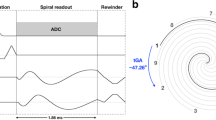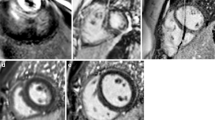Abstract
Background
Imaging the heart in children comes with the challenge of constant cardiac motion. A prospective electrocardiography-triggered CT scan allows for scanning during a predetermined phase of the cardiac cycle with least motion. This technique requires knowing the optimal quiescent intervals of cardiac cycles in a pediatric population.
Objective
To evaluate high-temporal-resolution cine MRI of the heart in children to determine the relationship of heart rate to the optimal quiescent interval within the cardiac cycle.
Materials and methods
We included a total of 225 consecutive patients ages 0–18 years who had high-temporal-resolution cine steady-state free-precession sequence performed as part of a magnetic resonance imaging (MRI) or magnetic resonance angiography study of the heart. We determined the location and duration of the quiescent interval in systole and diastole for heart rates ranging 40–178 beats per minute (bpm). We performed the Wilcoxon signed rank test to compare the duration of quiescent interval in systole and diastole for each heart rate group.
Results
The duration of the quiescent interval at heart rates <80 bpm and >90 bpm was significantly longer in diastole and systole, respectively (P<.0001 for all ranges, except for 90–99 bpm [P=.02]). For heart rates 80–89 bpm, diastolic interval was longer than systolic interval, but the difference was not statistically significant (P=.06). We created a chart depicting optimal quiescent intervals across a range of heart rates that could be applied for prospective electrocardiography-triggered CT imaging of the heart.
Conclusion
The optimal quiescent interval at heart rates <80 bpm is in diastole and at heart rates ≥90 bpm is in systole. The period of quiescence at heart rates 80–89 bpm is uniformly short in systole and diastole.


Similar content being viewed by others
References
Lee T, Tsai IC, Fu YC et al (2006) Using multidetector-row CT in neonates with complex congenital heart disease to replace diagnostic cardiac catheterization for anatomical investigation: initial experiences in technical and clinical feasibility. Pediatr Radiol 36:1273–1282
Jin KN, Park EA, Shin CI et al (2010) Retrospective versus prospective ECG-gated dual-source CT in pediatric patients with congenital heart diseases: comparison of image quality and radiation dose. Int J Cardiovasc Imaging 26:63–73
Paul JF, Rohnean A, Sigal-Cinqualbre A (2010) Multidetector CT for congenital heart patients: what a paediatric radiologist should know. Pediatr Radiol 40:869–875
Ben Saad M, Rohnean A, Sigal-Cinqualbre A et al (2009) Evaluation of image quality and radiation dose of thoracic and coronary dual-source CT in 110 infants with congenital heart disease. Pediatr Radiol 39:668–676
Herzog C, Arning-Erb M, Zangos S et al (2006) Multi-detector row CT coronary angiography: influence of reconstruction technique and heart rate on image quality. Radiology 238:75–86
Wintersperger BJ, Nikolaou K, von Ziegler F et al (2006) Image quality, motion artifacts, and reconstruction timing of 64-slice coronary computed tomography angiography with 0.33-second rotation speed. Investig Radiol 41:436–442
Leschka S, Husmann L, Desbiolles LM et al (2006) Optimal image reconstruction intervals for non-invasive coronary angiography with 64-slice CT. Eur Radiol 16:1964–1972
Leschka S, Wildermuth S, Boehm T et al (2006) Noninvasive coronary angiography with 64-section CT: effect of average heart rate and heart rate variability on image quality. Radiology 241:378–385
Leschka S, Scheffel H, Desbiolles L et al (2007) Image quality and reconstruction intervals of dual-source CT coronary angiography: recommendations for ECG-pulsing windowing. Investig Radiol 42:543–549
Husmann L, Leschka S, Desbiolles L et al (2007) Coronary artery motion and cardiac phases: dependency on heart rate — implications for CT image reconstruction. Radiology 245:567–576
Seifarth H, Wienbeck S, Pusken M et al (2007) Optimal systolic and diastolic reconstruction windows for coronary CT angiography using dual-source CT. AJR Am J Roentgenol 189:1317–1323
Weustink AC, Mollet NR, Pugliese F et al (2008) Optimal electrocardiographic pulsing windows and heart rate: effect on image quality and radiation exposure at dual-source coronary CT angiography. Radiology 248:792–798
Araoz PA, Kirsch J, Primak AN et al (2009) Optimal image reconstruction phase at low and high heart rates in dual-source CT coronary angiography. Int J Cardiovasc Imaging 25:837–845
Goetti R, Feuchtner G, Stolzmann P et al (2010) High-pitch dual-source CT coronary angiography: systolic data acquisition at high heart rates. Eur Radiol 20:2565–2571
Horii Y, Yoshimura N, Hori Y et al (2011) Relationship between heart rate and optimal reconstruction phase in dual-source CT coronary angiography. Acad Radiol 18:726–730
Jadhav SP, Golriz F, Atweh LA et al (2015) CT angiography of neonates and infants: comparison of radiation dose and image quality of target mode prospectively ECG-gated 320-MDCT and ungated helical 64-MDCT. AJR Am J Roentgenol 204:W184–W191
Nie P, Wang X, Cheng Z et al (2012) Accuracy, image quality and radiation dose comparison of high-pitch spiral and sequential acquisition on 128-slice dual-source CT angiography in children with congenital heart disease. Eur Radiol 22:2057–2066
Paul JF, Rohnean A, Elfassy E, Sigal-Cinqualbre A (2011) Radiation dose for thoracic and coronary step-and-shoot CT using a 128-slice dual-source machine in infants and small children with congenital heart disease. Pediatr Radiol 41:244–249
Johnson KR, Patel SJ, Whigham A et al (2004) Three-dimensional, time-resolved motion of the coronary arteries. J Cardiovasc Magn Reson 6:663–673
Author information
Authors and Affiliations
Corresponding author
Ethics declarations
Conflicts of interest
None
Rights and permissions
About this article
Cite this article
Zhang, W., Bogale, S., Golriz, F. et al. Relationship between heart rate and quiescent interval of the cardiac cycle in children using MRI. Pediatr Radiol 47, 1588–1593 (2017). https://doi.org/10.1007/s00247-017-3918-6
Received:
Revised:
Accepted:
Published:
Issue Date:
DOI: https://doi.org/10.1007/s00247-017-3918-6




